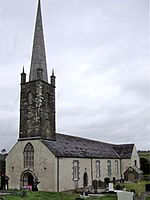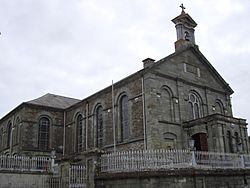Bishop of Ross (Ireland) facts for kids
The Bishop of Ross was an important religious leader in Ireland, specifically in the area around Rosscarbery in County Cork. A bishop is a high-ranking church official who oversees a group of churches called a diocese. The title "Bishop of Ross" is no longer a separate role today.
In the Church of Ireland, the duties of the Bishop of Ross are now part of the role of the Bishop of Cork, Cloyne and Ross. In the Roman Catholic Church, these duties are handled by the Bishop of Cork and Ross. This means that the areas once covered by the Bishop of Ross are now combined with other bishoprics.
Contents
Early Bishops of Ross
Before the Reformation (a big change in Christianity in the 1500s), the Bishop of Ross was a standalone position. These early bishops played a key role in the church life of the region. They were responsible for leading the local churches and their communities.
Many of these bishops served for a long time. For example, Daniel was bishop from about 1196 to 1223. Another important figure was Fingen Ó Clothna, who served from 1224 to around 1253. Some bishops, like Matthaeus, were chosen but never fully took over the role.
The bishops were often chosen by local church leaders or appointed by the Pope, the head of the Catholic Church. Sometimes, a bishop might be asked to help out in other areas, acting as a "suffragan bishop" (an assistant bishop) in different dioceses.
Bishops During the Reformation
The Reformation brought big changes to the church in Ireland. During this time, there were often different bishops for the same area, one supported by the Pope (Roman Catholic) and another by the English Crown (Church of Ireland).
Dermot MacCarthy was a Roman Catholic Bishop of Ross from 1526 to 1552. After him, Maurice O'Fihely served from 1554 to 1559. These bishops faced challenges as the religious landscape of Ireland changed.
Bishops After the Reformation
After the Reformation, the role of the Bishop of Ross split into two main lines: the Church of Ireland succession and the Roman Catholic succession.
Church of Ireland Bishops
For the Church of Ireland, the Bishop of Ross title was soon combined with other bishoprics. In 1582, William Lyon was appointed Bishop of Ross. However, just a year later, in 1583, the bishopric of Ross was joined with Cork and Cloyne. From then on, the Church of Ireland bishops for this area were known as the Bishop of Cork, Cloyne and Ross. This union meant that one bishop oversaw a much larger region.
Roman Catholic Bishops
The Roman Catholic line of bishops for Ross continued separately for a longer time. After the Reformation, bishops like Maurice O'Hea (1559–1561) and Thomas O'Herlihy (1561–1580) served. These bishops often faced difficult times due to political and religious changes in Ireland.
Sometimes, instead of a full bishop, the Pope would appoint a "vicar apostolic" or "apostolic administrator." These were temporary leaders who managed the diocese when a bishop couldn't be appointed or was absent. For example, Eugene Egan (I.) was a vicar apostolic in 1597.
A notable Roman Catholic Bishop of Ross was Boetius MacEgan, who was appointed in 1647. He was a strong leader during a very turbulent period in Irish history.
In 1747, the Roman Catholic bishopric of Ross was combined with Cloyne, becoming the "Bishopric of Cloyne and Ross." This union lasted for many years.
However, in 1850, Ross became a separate bishopric again with the appointment of William Keane. Later bishops included Micheal O'Hea (1857–1876) and Denis Kelly (1897–1924).
Finally, in 1958, the Roman Catholic bishopric of Ross was united with Cork to form the "Bishopric of Cork and Ross." Since then, one bishop has led both areas, bringing together these historic church titles.



